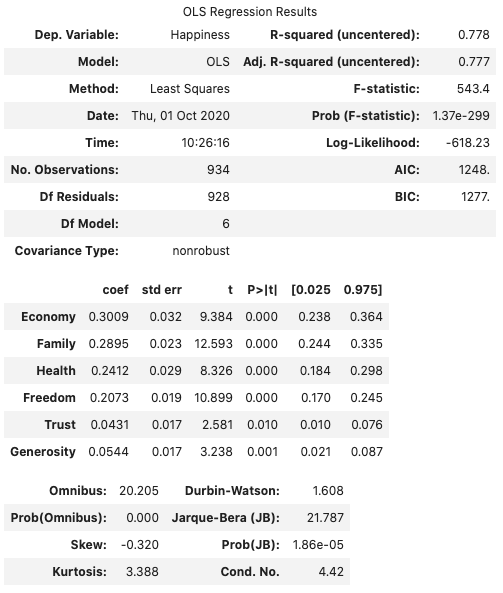I'm hoping to reproduce the following figure from Matt Taddy's book Business Data Science using the Happiness data set from Kaggle.
Running linear regression using lasso regularization, he observes a minimum in the out-of-sample (OOS) mean squared error and asserts that this value of lambda represents a good choice for regularization. Makes sense.
When I try the same thing on the happiness data set, a couple things look right: in-sample MSE is lower than out-of-sample MSE, and coefficients go to zero as regularization parameter is increased.
However, I don't see any drop in out-of-sample mean squared error with increasing lambda -- it's noisy and flat (top plot, orange trace).
As I understand it, dialing up lambda (sklearn.linear_model.Lasso() calls this alpha) should reduce OOS MSE as the fitted coefficients generalize better to the unseen data.
Why might I not be seeing a minimum in OOS MSE?
I wrote up the code myself because I wanted to understand how it works. I used 10-fold cross-validation with shuffled sampling and scanned 300 points across the regularization range of 10^-12 <= alpha <= 1.
Here it is:
# k-fold cross validation with lasso regularization
import numpy as np
alphas = np.logspace(-12, 0, 301)
coefs_all = []
coefs_avg_all = []
coefs_std_all = []
mse_train_avg_all = []
mse_test_avg_all = []
mse_train_std_all = []
mse_test_std_all = []
for alpha in alphas:
# randomly split data into k folds
from sklearn.model_selection import KFold
folds = 10
kf = KFold(n_splits=folds, shuffle=True)
coefs = []
mse_train = []
mse_test = []
for train_index, test_index in kf.split(X):
X_train, X_test = X.iloc[train_index], X.iloc[test_index]
y_train, y_test = y.iloc[train_index], y.iloc[test_index]
# build model on training data and get coefficients
from sklearn import linear_model
lasso = linear_model.Lasso(alpha=alpha)
lasso.fit(X_train, y_train)
coefs_fold = lasso.coef_
# get mean squared error of model predictions
y_pred_train_fold = np.dot(X_train, coefs_fold)
y_pred_test_fold = np.dot(X_test, coefs_fold)
mse_train_fold = sum((y_train - y_pred_train_fold) ** 2) / len(y_train)
mse_test_fold = sum((y_test - y_pred_test_fold) ** 2) / len(y_test)
# for each fold, add coeffs and mses to growing list
coefs.append(coefs_fold)
mse_train.append(mse_train_fold)
mse_test.append(mse_test_fold)
# across folds at this alpha, get average values of coefficients, mses, and stdevs
coefs_avg_alpha = [sum(items) / len(coefs) for items in zip(*coefs)]
coefs_std_alpha = [np.std(items) for items in zip(*coefs)]
mse_train_avg_alpha = np.average(mse_train)
mse_test_avg_alpha = np.average(mse_test)
mse_train_std_alpha = np.std(mse_train)
mse_test_std_alpha = np.std(mse_test)
# compile these average values into growing list
coefs_avg_all.append(coefs_avg_alpha)
coefs_std_all.append(coefs_std_alpha)
mse_train_avg_all.append(mse_train_avg_alpha)
mse_test_avg_all.append(mse_test_avg_alpha)
mse_train_std_all.append(mse_train_std_alpha)
mse_test_std_all.append(mse_test_std_alpha)
# compile mean square error summary into dataframe
mse_df = pd.DataFrame({'Alpha': alphas,
'MSE train avg': mse_train_avg_all,
'MSE test avg': mse_test_avg_all,
'MSE train std': mse_train_std_all,
'MSE test std': mse_test_std_all})
# bind coefficients to previous dataframe
coefs_df = pd.DataFrame(coefs_avg_all, columns=X.columns.to_list())
lasso_cv_summary_df = pd.concat([mse_df, coefs_df], axis=1)






sklearn.preprocessing.StandardScaler. This is really important, since you want all your features to have the same scale properties so that the regularization penalty applies fairly across all of them. $\endgroup$StandardScalerby subtracting the mean and dividing by the standard deviation (df_norm = ( df - df.mean() ) / df.std()). I will take your advice and invert the order of alpha and CV loops to see how OOS MSE vs. alpha looks with the same train and test sets across alpha. $\endgroup$shuffle=FalseinKFold()accomplishes the same thing. However, OOS MSE vs. alpha remains perfectly flat! At no value of alpha does the model perform better on unseen data than the unregularized (i.e., alpha=0) model. This is surprising to me and I'm still thinking that something's probably not right with my code. $\endgroup$